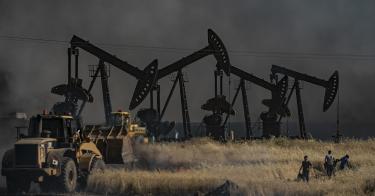In 1974 President Richard Nixon declared, "At the end of this decade, in the year 1980, the United States will not be dependent on any other country for the energy we need."
So when President Donald Trump recently said, "We are independent, and we do not need Middle East oil," did he finally accomplish what his eight predecessors vowed to do?
Not exactly. We're much less dependent on Middle East oil than we used to be, yes, but not entirely so—and in fact, we can't be.
For starters, oil is a globally traded commodity. Whether the U.S. is a net importer or exporter of oil, we cannot completely insulate Americans from price volatility any more than U.S. self-sufficiency in orange or coffee production will prevent supply problems in other parts of the world from affecting domestic prices.
The price of crude oil makes up slightly more than half of the price for a gallon of gasoline. A number of factors around the world affect the supply of and demand for oil, which in turn affects the price Americans pay at the pump.
The Middle East, led by Saudi Arabia, still plays a huge role. A third of the world's oil passes through the Strait of Hormuz daily. Major supply disruptions can still inflict a lot of economic pain on American consumers and the economy.
Because of the global connectedness of oil markets, the U.S. still imported about 9.94 million barrels of petroleum in 2018 from 90 different countries. That's not a bad thing. Americans benefit through lower prices and increased economic activity from a more efficient global oil market.
Moreover, a barrel of oil extracted in Texas isn't the same as a barrel extracted in Saudi Arabia. Crude can range from very light to very heavy depending on its density, and sweet to sour depending on its sulfur content. Through open markets and a continual flow of imports and exports, matching refining capabilities that are more suited for different types of crude benefits us all.
Although the U.S. will never be completely detached from the global oil markets, America's increased supplies and inventories is providing a welcome cushion to withstand the adverse economic impacts of geopolitical events. Because of the drive of American entrepreneurs, domestic oil production has more than doubled since January 2010 to more than 12.5 million barrels per day.
The United States is now the world's largest oil producer, which is great news if you like affordable energy, more jobs and higher levels of prosperity.
Moreover, getting more domestic oil and refined petroleum products into the market is serving as a price shock absorber.
The situation with Iran is the latest in a number of events over the past two years that could have sent oil prices skyrocketing—but didn't. In September, attacks on Saudi Arabian facilities briefly took 5.7 million barrels per day offline. Last spring, a drone strike shut down a Saudi Arabian pipeline, and two oil tankers were attacked. Furthermore, Venezuela's economic collapse and sanctions on Iran have removed significant sources of supply.
And in the U.S., tropical cyclone activity in the Gulf Coast the past two years threatened both extraction and refining. While some supply disruptions caused prices at the pump to increase, including a 20% bump after the Saudi installation attacks, there was no prolonged period of price spikes.
As Ashley Petersen, senior oil market analyst for Stratas Advisors, told news outlet Axios, "The U.S. oil boom is the primary reason nobody is seriously discussing triple-digit oil prices even with everything that is going on and went on this summer."
This certainly wasn't always the case.
As C.K. Hickey wrote in Foreign Policy, "Previous Middle East crises resulted in greater disruptions of the oil market. The August 1990 Iraqi invasion of Kuwait led to a surge in the price of oil from $15 a barrel that month to $40 by October ($65.68 adjusted for inflation as of 2019). In February 2003, the lead-up to the U.S. invasion of Iraq once again led to a spike in prices to nearly $40 a barrel, or around $55 in today's dollars, a level that hadn't been seen since the Gulf War."
Yet, America's significant increase in production has fundamentally shifted the global energy landscape. Last fall, for the first time in 75 years, the U.S. was a net exporter of crude oil and refined petroleum products. Through the power of free enterprise, imports of crude oil to the U.S from Persian Gulf Countries hit record lows. American producers are exporting more crude oil than the entire country of Iran produces.
Nevertheless, so long as consumers are filling up their cars with gas, the U.S. will never be fully energy independent. And the Middle East will likely remain a larger part of the global oil market well into the future. But thanks to America's energy revolution, we're in a much better situation economically and geopolitically than we were when President Nixon made those comments 46 years ago.
This piece originally appeared in The Sacramento Bee




